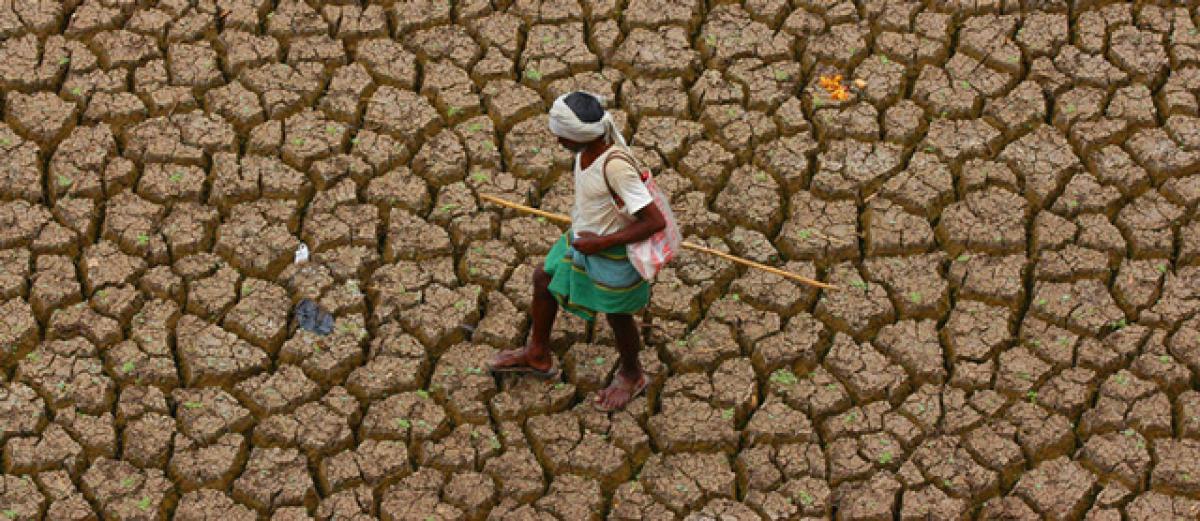Live
- AR Rahman’s ‘Aadujeevitham’ Music Nominated Twice at 2024 Hollywood Awards
- NBK’s action drama ‘Daaku Maharaaj’ unveiled with power-packed teaser
- Nehru’s services unforgettable : Veerlapalli
- ROB ready by March-end
- 30.1-9-49-10 – Anshul Kamboj picks up all 10 wickets in Haryana vs Kerala Ranji Trophy match
- South Korean FM Cho, Blinken hold talks on margins of APEC summit in Peru
- India’s insurance sector growth surpasses China, Thailand: McKinsey
- CLOSE-IN: Indian cricketers from Paupers to Princelings
- Delhi-NCR's air quality remains hazardous for residents
- South Korea, US, Japan to announce establishment of trilateral secretariat this week
Just In

It is difficult to provide a precise and universally accepted definition of drought due to its varying characteristics and impacts across different regions such as rainfall patterns, human response and resilience etc.
It is difficult to provide a precise and universally accepted definition of drought due to its varying characteristics and impacts across different regions such as rainfall patterns, human response and resilience etc. Drought is a normal, recurrent feature of climate and occurs in all climatic regimes and is usually characterized in terms of its spatial extension, intensity and duration. Drought causes economic, environmental and social impacts.
Ministry of Agriculture is the nodal Ministry in respect of monitoring and managing drought conditions and droughts are classified into meteorological droughts, hydrological droughts and agricultural droughts.Meteorological drought is classified based on rainfall deficiency w.r.t. long term average – 25% or less is normal, 26-50% is moderate and more than 50% is severe.
Hydrological drought is best defined as deficiencies in surface and sub-surface water supplies leading to a lack of water for normal and specific needs. Such conditions arise even in times of average (or above average) precipitation when increased usage of water diminishes the reserves.
Agricultural drought is identified by 4 consecutive weeks of meteorological drought, weekly rainfall is 50 mm from 15/5/ to 15/10, 6 such consecutive weeks rest of the year and crop planted is 80% in kharif season.
In India, around 68% of the country is prone to drought in varying degrees. 35% which receives rainfall between 750 mm and 1125 mm is considered drought prone while 33% receiving less than 750 mm is chronically drought prone.
IMD is the designated agency for providing drought early warning and forecasting. Agricultural Meteorology Division, Pune provides timely advice on the actual and expected weather and its likely impact on the various day-to-day farming operations.
Drought Research Unit, Pune provides Crop Yield Forecasts. The National Centre for Medium Range Weather Forecasting, a constituent unit of the Department of Science & Technology provides, in consultation with IMD, ICAR and State Agricultural Universities, agro-meteorological advisory service at the scale of agro-climatic zones to the farming community, based on location specific medium range weather forecasts.
The Central Research Institute for Dryland Agriculture (CRIDA), Hyderabad and the All India Coordinated Research Projects on Agri-Meteorology and Dryland Agriculture (AICRPAM and AICRPDA) each of them having 25 centres across the country, take part in drought studies pertaining to assessment, mitigation, risk transfer and development of decision support software for drought prone States.

© 2024 Hyderabad Media House Limited/The Hans India. All rights reserved. Powered by hocalwire.com







